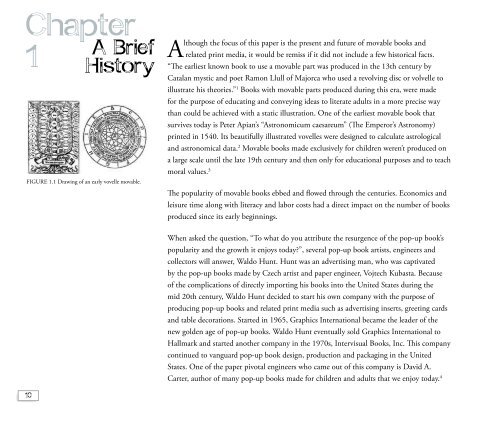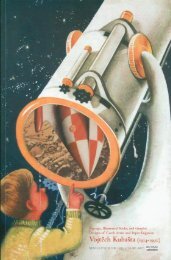NEXT STOP: POP-UPS - The Popuplady
NEXT STOP: POP-UPS - The Popuplady
NEXT STOP: POP-UPS - The Popuplady
Create successful ePaper yourself
Turn your PDF publications into a flip-book with our unique Google optimized e-Paper software.
Chapter<br />
1<br />
A Brief<br />
History<br />
FIGURE 1.1 Drawing of an early vovelle movable.<br />
A<br />
lthough the focus of this paper is the present and future of movable books and<br />
related print media, it would be remiss if it did not include a few historical facts.<br />
“<strong>The</strong> earliest known book to use a movable part was produced in the 13th century by<br />
Catalan mystic and poet Ramon Llull of Majorca who used a revolving disc or volvelle to<br />
illustrate his theories.” 1 Books with movable parts produced during this era, were made<br />
for the purpose of educating and conveying ideas to literate adults in a more precise way<br />
than could be achieved with a static illustration. One of the earliest movable book that<br />
survives today is Peter Apian’s “Astronomicum caesareum” (<strong>The</strong> Emperor’s Astronomy)<br />
printed in 1540. Its beautifully illustrated vovelles were designed to calculate astrological<br />
and astronomical data. 2 Movable books made exclusively for children weren’t produced on<br />
a large scale until the late 19th century and then only for educational purposes and to teach<br />
moral values. 3<br />
<strong>The</strong> popularity of movable books ebbed and flowed through the centuries. Economics and<br />
leisure time along with literacy and labor costs had a direct impact on the number of books<br />
produced since its early beginnings.<br />
When asked the question, “To what do you attribute the resurgence of the pop-up book’s<br />
popularity and the growth it enjoys today?”, several pop-up book artists, engineers and<br />
collectors will answer, Waldo Hunt. Hunt was an advertising man, who was captivated<br />
by the pop-up books made by Czech artist and paper engineer, Vojtech Kubasta. Because<br />
of the complications of directly importing his books into the United States during the<br />
mid 20th century, Waldo Hunt decided to start his own company with the purpose of<br />
producing pop-up books and related print media such as advertising inserts, greeting cards<br />
and table decorations. Started in 1965, Graphics International became the leader of the<br />
new golden age of pop-up books. Waldo Hunt eventually sold Graphics International to<br />
Hallmark and started another company in the 1970s, Intervisual Books, Inc. This company<br />
continued to vanguard pop-up book design, production and packaging in the United<br />
States. One of the paper pivotal engineers who came out of this company is David A.<br />
Carter, author of many pop-up books made for children and adults that we enjoy today. 4<br />
FIGURE 1.2 Vovelle from “Astronomicum caesareum”, 1540<br />
FIGURE 1.3 Paper engineering by Vojtech Kubasta, 1960 FIGURE 1.4 Paper engineering by Waldo Hunt, Wrigley’s Gum Ad<br />
10 11



